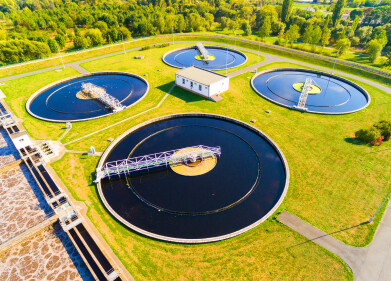Sewage monitoring
Preventing dangers in the water and sewage treatment industry
Dec 07 2022
For most of us, purification plants are associated with only one minor nuisance: their smell. For everyone working on the plants however, the potentially present gases are a permanent danger that needs to be considered. These gases need to be monitored to ensure the safety of all workers.
No matter where you work – you need to have a portable gas detector on you
There are many confined spaces in purification plants, including aeration basins, sedimentation basins or cisterns. These areas are dangerous in themselves, but the gases contaminating the atmosphere inside them increase the risk even further.
Methane and hydrogen sulfide – both byproducts of the decomposition of organic substances in wastewater - can lead to oxygen deficiency, inhalation poisoning or even explosions. The chemicals used for decontaminating and purifying the waste water are also dangerous for everyone working at these locations. Chlorine, ammonia, and chlorine dioxide are among the gases often found in purification plants. In high concentrations, they pose a health risk when inhaled. As it is difficult to remove these hazardous gases from the wastewater treatment process, anyone working at the plant must have access to reliable gas detection devices, especially portable gas detectors. GfG offers compact gas detectors, such as the Micro 5 for one or two gases, if you need to detect a particular danger or multi-gas detectors like the G999C which can detect up to seven different gases.
Fixed gas detection systems increase the safety of critical spots around the clock
It is widely known that every employer is obligated to eliminate or reduce occupational risks to ensure the safety and protection of their employees while at the workplace. To do so, they have to adopt appropriate measures and implement them according to the general principals of prevention. This includes creating collective safety measures, which take precedence over individual protection measures. This means that gas detection systems must be installed at fixed points throughout the location. GfG can provide a unique system which is able to measure gas concentrations in any hard-to-reach location, including lifting stations, air treatment systems, ventilation shafts and all enclosed spaces that need to be accessed. The GMA200-MGSS is able to detect the following gases: H2S, CH4 and other hydrocarbons (% LEL) as well as oxygen concentrations. The MGSS features multiple accessories facilitating a reliable treatment of the air that needs to be analyzed. It comes with water and dust filters with optional condensate drainage via a peristaltic pump that can be controlled directly from the MGSS, cooling coils (stainless-steel or copper, depending on the measured gas) that regulate the temperature, and also water stopping filters as well as flame arrester, in case you need to monitor in ATEX classified areas.
Combine portable and fixed solutions for maximum safety
Portable gas detectors and fixed gas detection systems should not be considered separate entities. While every system will increase the safety of your plant by itself, you should rely on both to ensure you will be able to react to any present gas concentrations before they can reach a critical level. That is why GfG is also heavily researching the integration of portable devices into fixed systems.
If you have any questions, our experts will be happy to help you.
Digital Edition
AET 28.4 Oct/Nov 2024
November 2024
Gas Detection - Go from lagging to leading: why investment in gas detection makes sense Air Monitoring - Swirl and vortex meters will aid green hydrogen production - Beyond the Stack: Emi...
View all digital editions
Events
Jan 12 2025 Abu Dhabi, UAE
Jan 14 2025 Abu Dhabi, UAE
Jan 20 2025 San Diego, CA, USA
Carrefour des Gestions Locales de L'eau
Jan 22 2025 Rennes, France
Safety, Health & Wellbeing LIVE
Jan 22 2025 Manchester, UK
water-treatment_1.jpg)
water-treatment_2.jpg)
water-treatment_3.jpg)


















